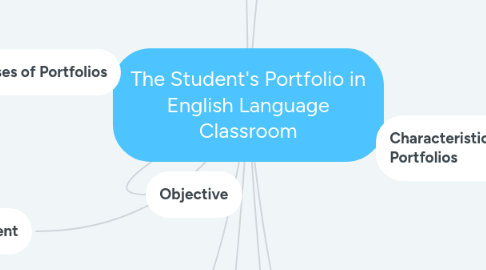
1. Objective
2. Purposes of Portfolios
2.1. Student
2.1.1. To demonstrate knowledge of a topic
2.1.1.1. Advantages
2.1.1.1.1. To promote self-evaluation and critical thinking.
2.1.1.1.2. To reinforce extensive input.
2.1.1.1.3. To show progress in learning goals.
2.2. Teacher
2.2.1. To measure students progress
3. Portfolio Development
3.1. Organization & Planning
3.1.1. Decision of materials and items.
3.2. Collection
3.2.1. Decision about content and context of products based on purposes.
3.3. Reflection
3.3.1. Reflection upon the products & procedures.
4. Portfolio Assessment
4.1. To show a well-thought-out evaluation
4.1.1. Teachers must score:
4.1.1.1. cognitive reflection
4.1.1.2. Growth and development in the curriculum expectancies.
4.1.1.3. comprehension of core processes.
4.1.1.4. appropriateness of products shown in the portfolio.
4.1.1.5. achievement of required information.
5. To show interests, accomplishments, and objectives achieved.
6. Conclusion
6.1. To start with the portfolio process:
6.1.1. Keep it simple.
6.1.2. Start with a single unit.
6.1.3. Determine the goals and purposes of the portfolio.
6.1.4. Create a checklist.
6.1.5. Explain the process and encourage students to work in the development of the portfolios.
6.2. Benefits of the portfolio:
6.2.1. Enhancement of critical thinking skills to:
6.2.1.1. develop evaluation criteria.
6.2.1.2. use criteria to evaluate their work.
6.2.1.3. engage in self-reflection about their progress.
7. Types o Portfolios
7.1. Process Portfolio
7.1.1. To file stages of learning from Basic to Advanced mastery.
7.1.2. To provide the progress of students knowledge growth.
7.2. Product or Showcase Portfolio
7.2.1. Can serve as a classroom assessemt on program
7.2.2. To show the best work through audio-visual aids, photos and electronic record as an evidence of students' accomplishments.
8. Characteristics of Effective Portfolios
8.1. To provide formative and summative assessment.
8.2. To reflect students learning process.
8.3. To focus on students' performance, knowledge, skills and attitudes.
8.4. To provide for collaborative reflection to:
8.4.1. reflect about
8.4.1.1. their own thinking progress
8.4.1.2. cognitive introspection
8.4.1.3. problem solving
8.4.1.4. decision making
8.4.2. observe
8.4.2.1. emerging understanding of subjects and skills
8.5. To focus upon
8.5.1. students' performance-based learning experiences.
9. Authenticity
9.1. The portfolio is authentic when it coveers the linguistic and real knowledge of the students contexts such as:
9.1.1. real world stuations.
9.1.2. academic assignments and non- academic tasks.
9.1.3. the first and second language of the student.
